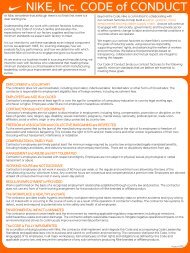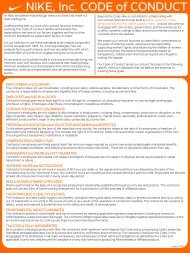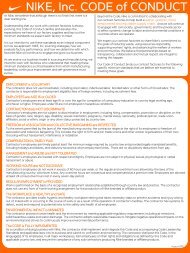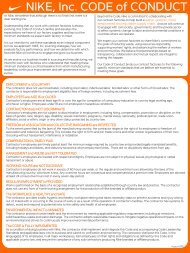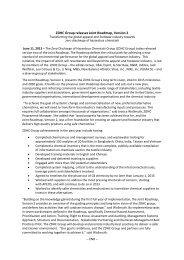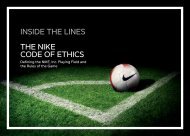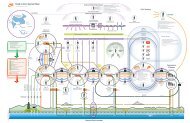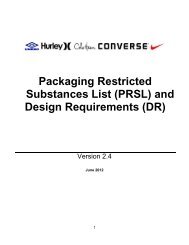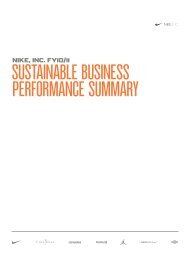COC CLS - Healthy Safety Environment - NIKE, Inc. - The Journey
COC CLS - Healthy Safety Environment - NIKE, Inc. - The Journey
COC CLS - Healthy Safety Environment - NIKE, Inc. - The Journey
Create successful ePaper yourself
Turn your PDF publications into a flip-book with our unique Google optimized e-Paper software.
OCCUPATIONAL NOISE EXPOSURE<br />
STANDARD<br />
<strong>The</strong> contractor provides a safe, hygienic and healthy workplace setting and takes necessary steps to<br />
prevent accidents and injury arising out of, linked with or occurring in the course of work or as result of<br />
the operation of contractor’s facilities. <strong>The</strong> contractor has systems to detect, avoid and respond to<br />
potential risks to the safety and health of all employees.<br />
‣ Develop and implement a noise exposure program to reduce noise levels and/or protect<br />
employees and contractors from noise levels that will cause hearing loss.<br />
RESPONSIBILITIES<br />
Location Manager must ensure that the noise exposure program is developed, implemented and<br />
followed.<br />
HSE Representative must establish, maintain and administer the noise exposure program.<br />
Managers and Supervisors must ensure that employees are trained and adhere to the requirements of<br />
the noise exposure program.<br />
Employees must adhere to the requirements of the noise exposure program.<br />
REQUIREMENTS<br />
1. RISK ASSESSMENT—Each facility must have a documented risk assessment performed which includes<br />
as a minimum:<br />
a. Conduct a noise assessment to Identify high noise areas. High noise areas are defined as 85 dB<br />
or greater.<br />
b. Evaluate the risk associated with high noise (e.g., hearing loss, concentration, unable to hear fire<br />
alarms).<br />
c. Evaluate controls to reduce noise exposure to less than a minimum of 85 dB:<br />
• Engineering controls should be considered as first and best option.<br />
• Personal protective equipment should be considered as a last option.<br />
2. POLICIES & PROCEDURES—Each facility with identified noise levels above 85 dB must have<br />
implemented procedures to reduce or eliminate the risk of hearing loss which must cover, as a<br />
minimum, the following:<br />
a. Noise monitoring when there has been a significant change in machinery or production<br />
processes.<br />
b. Signs indicating areas where hearing protection is required.<br />
c. Availability and use of hearing protection in required areas.<br />
d. Evaluation of hearing protection to determine effectiveness for indicated noise levels.<br />
3. HEARING TESTING—Each facility must have a hearing testing program for affected employees that<br />
includes, as a minimum:<br />
<strong>Safety</strong> <strong>CLS</strong> – Page 1<br />
04.14.10



